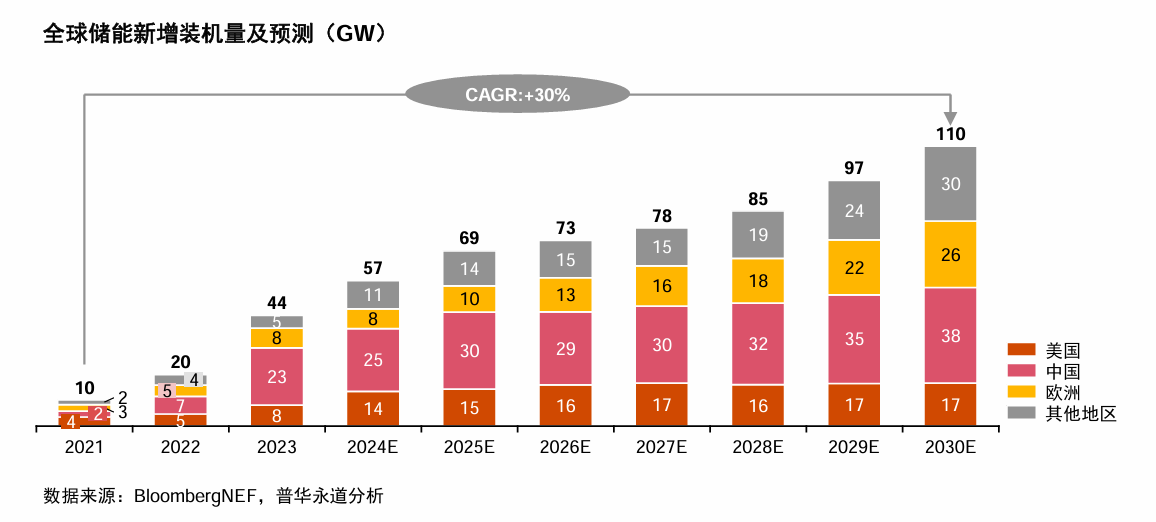According to PwC, the scale of the overseas energy storage market is growing steadily, the market is relatively mature, and the profit model is diversified and the returns are considerable. It is estimated that by 2030, the global energy storage market will reach 110GW, with a CAGR of 30%. In addition to China, the United States and Europe will add 17GW and 26GW of new installed capacity in 2023, with Europe and the United States contributing the main increment, and the market potential is huge. In the context of the rapid expansion of the global energy storage market and the introduction of trade protection policies and new tariff policies in various countries, China's leading energy storage companies have accelerated their overseas layout and occupied a place in overseas markets.
However, the road to the sea is not all smooth sailing, such as battery cells, packs and other parts are lower than traditional overseas products, and the brand value that can be provided is also relatively limited. Correspondingly, in the face of the future of integrated services going overseas, the supply of grid-based energy storage systems and the provision of integrated solutions of "source-grid-load-storage" can provide higher added value. The grid-based energy storage system supply refers to the energy storage system that can support the safe and stable operation of the power grid, which is suitable for large power grids and microgrids. Grid-based energy storage adopts grid-based converter technology, which is a solution to the safety and stability problems brought about by the trend of "double high" (high proportion of renewable energy and high proportion of power electronic equipment) in the power system. The grid-based energy storage system is essentially a voltage source, which can internally set voltage parameters and output stable voltage and frequency. This kind of system can not only be connected to the grid, but also can be operated off-grid, and has a strong support capacity for the power grid. Due to the characteristics of its voltage source, the grid-based energy storage system can effectively improve the short-circuit capacity and the lack of moment of inertia in the new power system, so it has an important application prospect in the new power system.

Figure: Global new energy storage capacity and forecast
The integration of source, grid, load and storage is a new type of power system operation mode, which plans and regulates the four links of power supply, power grid, load and energy storage as a whole. The core purpose of source-grid-load-storage integration is to promote the precise matching of supply and demand, maximize the use of clean energy, and solve the problem of grid stability caused by the volatility, intermittency and randomness of new energy. This mode is an important development path for building a new power system by improving the dynamic balance of power system through various interactive forms such as source complementarity, source-grid coordination, grid-load interaction, grid-storage interaction and source-load interaction.
According to PwC, from basic products such as traditional battery cells to becoming a global supplier of customized energy storage systems will become the future trend of Chinese enterprises to go overseas, and it is also a way to enhance the influence of global brands. The accumulation of this global brand will help energy storage companies to better feed the domestic market in the future, and this road is the differentiated development path of energy storage enterprises. By participating in international market competition, energy storage companies can continuously improve their technical level and product quality, thereby enhancing their brand value and international influence. Although the overseas market has great potential, the competition is also extremely fierce. Energy storage companies need to continuously improve their technical level and product quality to meet the challenges from domestic and foreign competitors. For example, global supply chain contradictions and the rise of trade protectionism have led to a shift in global trade from an efficiency model to a security model, and the value chain tends to be localized. Chinese energy storage companies are facing shocks in the restructuring of the global industrial chain and need to adapt to the continuous rebalancing of the energy storage industry in the geopolitical pattern.
The overseas market of the energy storage industry is growing rapidly, and it is of great significance for energy storage to go overseas to enhance brand value. However, enterprises also face many challenges in the process of going global, and they need to continuously improve their own strength and strengthen localized operations to cope with the competition in the international market.
Related:
Insights on Storage Energy Trends (1)
Insights on Storage Energy Trends (2)






